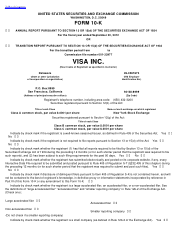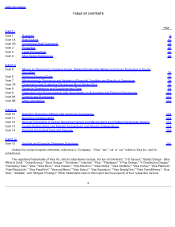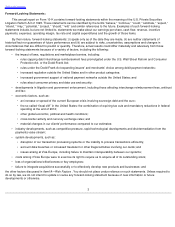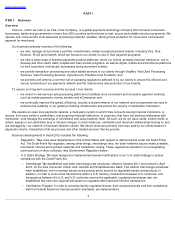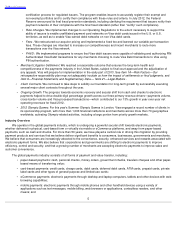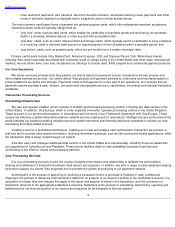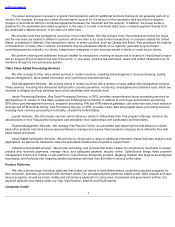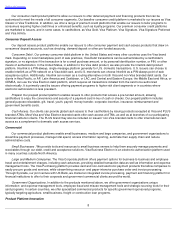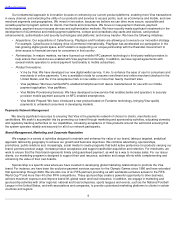Visa 2012 Annual Report Download - page 12
Download and view the complete annual report
Please find page 12 of the 2012 Visa annual report below. You can navigate through the pages in the report by either clicking on the pages listed below, or by using the keyword search tool below to find specific information within the annual report.
Table of Contents
Our client and merchant marketing activities bring added value through the development of marketing programs designed to
drive their specific business objectives. For merchant clients, these programs generate awareness for new acceptance channels
and locations and increase cardholder spending and merchant sales revenue through special offers and promotions. For issuer
clients, our marketing programs support their card issuance, activation and usage efforts while complementing and enhancing the
value of their own brands.
In addition, we work on various fronts to maintain, enhance and protect our corporate reputation and brand. Our Corporate
Responsibility program helps ensure we positively impact the lives of those in our global and local communities. We do so by
expanding financial inclusion and literacy, providing humanitarian aid and community support, and engaging in responsible
business practices. We continue to promote an understanding of Visa's role as a payments network and articulate the ways that
electronic payments can advance economic empowerment, remove friction from commerce and increase government efficiencies.
To that end, Currency of Progress, our corporate reputation campaign launched in October 2009, communicates the tangible
benefits that Visa and electronic payments deliver to individuals, businesses, governments and economies.
Merchant Acceptance Initiatives
We aim to maintain and expand our merchant base by focusing on the needs of merchants and consumers and enhancing
our programs to increase acceptance in attractive and fast-growing segments, such as bill payment. Our efforts to address these
needs include supporting the development of technological innovations, delivering value-added information services, and
evaluating potential modifications to our operating rules and interchange rates to enhance the value of our payments network
compared to other forms of payment. For example, we raised the limit for our “no signature required” program from $25 to $50 for
U.S. discount stores and grocery stores/supermarkets, enabling more face-to-face merchants to accept Visa cards for transactions
without requiring a cardholder signature, PIN or providing a receipt unless requested by the cardholder. This program can increase
speed at the point of sale, enhance consumer satisfaction and deliver operating efficiencies for merchants.
We also enter into arrangements with certain merchants under which they receive monetary incentives and rebates for
acceptance of products carrying our brands and increasing their payments volume of products carrying our brands or indicating a
preference for our products.
Client Standards
Rulemaking and Enforcement. In general, our clients are granted licenses to use our brands and to access our transaction
processing systems. Our clients are obligated to honor our rules and standards through agreements with, and in certain cases non-
equity membership interests in, our subsidiaries. These rules and standards relate to such matters as the use of our brands and
trademarks; the standards, design and features of payment cards, devices and programs; processing; merchant acquiring activities,
including use of agents; disputes between members; risk management; settlement indemnification; client financial failures and
allocation of losses among clients.
We establish and administer dispute management procedures between clients relating to specific transactions. For example,
after a transaction is presented to an issuer, the issuer may determine that the transaction is invalid for a variety of reasons,
including fraud. If the issuer believes there is a defect in a transaction, the issuer may return the transaction to the acquirer, an
action termed a “chargeback.” We enforce rules relating to chargebacks and maintain a dispute resolution process with respect to
chargeback disputes.
Credit Risk Management. We indemnify issuers and acquirers for any settlement loss suffered due to the failure of another
issuer or acquirer to fund its daily settlement obligations. In certain instances, we may indemnify clients even in situations in which a
transaction is not processed by our system. We have incurred no material loss related to settlement risk in recent years. See Item
1A—Risk Factors—We risk loss or insolvency if our clients fail to fund settlement obligations for which we have provided
indemnifications.
To manage our exposure in the event our clients fail to fund their settlement obligations, we established a credit risk policy
with a formalized set of credit standards and risk control measures. We regularly evaluate clients with significant settlement
exposure to assess risk. In certain instances, we may require a client to post collateral or provide other guarantees. If a client
becomes unable or unwilling to meet its obligations, we are able to draw upon such collateral or guarantee in order to minimize any
potential loss. We may also apply other risk control measures, such as blocking the authorization and settlement of transactions,
limiting the use of certain types of agents, prohibiting initiation of acquiring relationships with certain high-risk merchants or
suspending or terminating a client's rights to participate in our payments network. The exposure to settlement losses through our
indemnification
10


